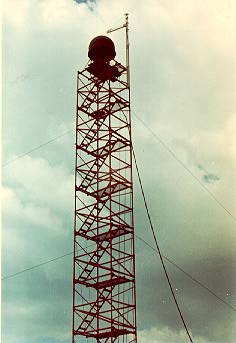
Our intrepid leaders at HQ (Headquarters) back at the Cu Chi base camp got a wild hair up their ass one day and decided that the stock 15 foot radar mast was inadequate (never mind that we were already acquiring lots of targets). They thought we could achieve better radar coverage and range by going even higher with the radar antenna. While they were somewhat correct on the technicalities, there were some other little details that they never mentioned to us directly.
The tower was issued to us in August, 1969, while we were based at ATSB Ben Keo, near a river. I was 5 months into my tour, so I had to deal with this contraption for 7 months. These towers were universal and could be used for many purposes, including radio communications. I recall seeing one at our base camp that appeared to be about 300 feet high and was loaded with all sorts of antennas. Perhaps we were lucky that our tower was “only” 84 feet high. 84 feet high in a forward combat zone. Can you imagine that?
Obviously, the tower ushered in a dramatic increase in our vulnerability. Specifically, anyone on that tower was an enemy sniper’s dream. The other little detail our intrepid geniuses ignored was the increased work effort. Disassembly, transportation and reassembly of the tower added dramatically to our work load, making it impossible to break camp one morning and be on the air at another camp that evening. But the weenie geniuses back at HQ demanded that we be on the air the same day of the move. This was incredibly unrealistic. In fact, it was impossible. Sure, we’d work our asses off until 2:00 AM and actually get the radar system powered up, but we couldn’t perform the last, critical step until daylight. That would be antenna orientation. This procedure required 2 of us to go a minimum of 1/4 mile outside the camp with an aiming circle device and shoot an azimuth back to the antenna, plus swing our helmet for positive ID by the operator. No surprise that no one went out there after dark. It would be suicide. But you just have to love those desk-bound warriors sitting in their comfy, safe bunker back at the base camp, barking orders. They probably put themselves in for a medal because of their tower idea. Of course, we didn’t receive any medals. Our reward was the hair standing up on the back of our necks (if we had any hair) and a greatly increased level of risk to our lives.
We were visited one whole time by the geniuses during my tour and that was 6 months after we inherited the tower. Do you think any of them climbed the tower during their visit? Even once? I mean, there was a great view from the top. Top of the Mark, right? Answer: Hell no! But I’ll tell you this: Their UH-1 helicopter was spit shined. I’m not exaggerating when I say that it looked better than factory-new. In addition, their boots were beautifully spit shined, not to mention their clean, pressed and tailored jungle fatigues; all this no doubt done by their hootch maids, who likely had a few other tricks up their sleeves. Witnessing all of that, I was convinced that we were winning the war. Yeah, sure. If you believe that, I have a certain bridge for sale.
As to the tower itself, each section consisted of one ladder and a catwalk and was 6 feet tall. A small white crane can be seen at the top. It was used to hoist tower sections during assembly and disassembly. The tubing in each section was made of thin-wall aluminum. We had the misfortune of having the tower fall over during our first disassembly when at the 24 foot level. We neglected to secure guy-wires to the next lower level. I got to ride it down along with another guy (see St. Elmo’s Fire). About two weeks after I left Vietnam the tower in this picture was blown down by a Monsoon. Two weeks after that, a sniper got the new guy while he was on the tower. He was 19.



